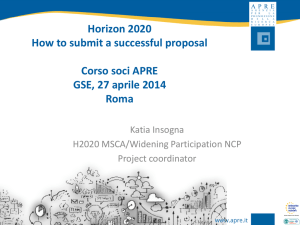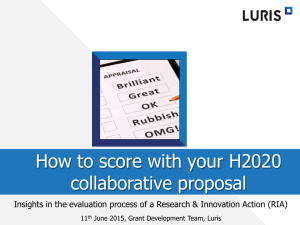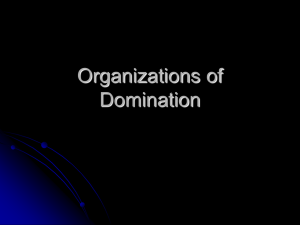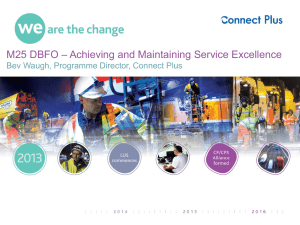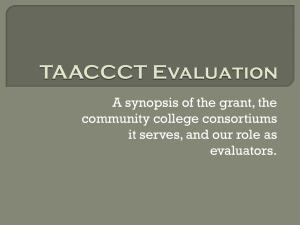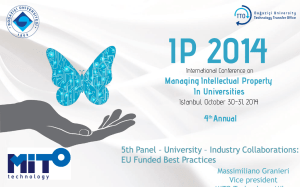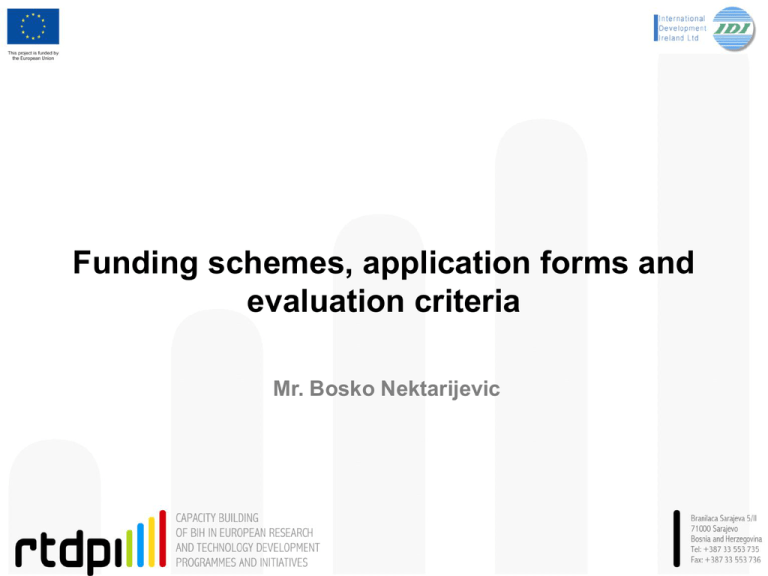
Funding schemes, application forms and
evaluation criteria
Mr. Bosko Nektarijevic
Types of actions supported by grants
• Research and Innovation Actions
• Innovation Actions
• Coordination and Support Actions
• SME instrument
Research and innovation actions
• Actions primarily consisting of activities
aiming to establish new knowledge and/or to
explore the feasibility of a new or improved
technology, product, process, service or
solution.
• For this purpose they may include basic and
applied research, technology development
and integration, testing and validation on a
small-scale prototype in a laboratory or
simulated environment.
Innovation actions
• Actions primarily consisting of activities
directly aiming at producing plans and
arrangements or designs for new, altered or
improved products, processes or services.
• For this purpose they may include
prototyping, testing, demonstrating, piloting,
large-scale product validation and market
replication.
Coordination and support actions
Actions consisting primarily of accompanying
measures
such
as
standardisation,
dissemination,
awareness-raising
and
communication, networking, coordination or
support services, policy dialogues and mutual
learning exercises and studies, including design
studies for new infrastructure and may also
include complementary activities of networking
and coordination between programmes in
different countries.
Proposal Structure
Overall Proposal Structure
Every proposal consists of 2 parts:
Part A: In this part you will be asked for certain
administrative details that will be used in the evaluation
and further processing of your proposal. Part A forms an
integral part of your proposal.
Part B: Contains the details of the work you intend to carry
out.
Proposals must be submitted electronically, using the
Commission’s Participant Portal
On the Participant Portal under the relevant call you can
download the
Proposal template
(technical annex)
These templates are different for
•Coordination and Support Actions CSA
•Innovation Actions IA
•Research and Innovation Actions RIA
Overview Part B (RIA)
Section 1: Excellence
1.1
Objectives
1.2
Relation to the work programme
1.3
Concept and approach
1.4
Ambition
Section 2: Impact
2.1
Expected impacts
2.2
Measures to maximise impact
Section 3: Implementation
3.1
Work plan — Work packages, deliverables and milestones
3.2
Management structure and procedures
3.3
Consortium as a whole
3.4
Resources to be committed
Section 4: Members of the consortium
4.1.
Participants (applicants)
4.2.
Third parties involved in the project
Section 5: Ethics and Security
5.1
Ethics
5.2
Security
Page Limits
For full proposals, the cover page, and sections 1, 2 and 3,
together should not be longer than 70 pages.
All tables in these sections must be included within this
limit.
The minimum font size allowed is 11 points. The page size
is A4, and all margins (top, bottom, left, right) should be at
least 15 mm (not including any footers or headers).
Section 1: Excellence
Section 1: Excellence
1.1 Objectives
Describe the specific objectives for the project, which
should be clear, measurable, realistic and achievable
within the duration of the project. Objectives should be
consistent with the expected exploitation and impact of
the project.
1.2 Relation to the work programme
Indicate the work programme topic to which your proposal
relates, and explain how your proposal addresses the
specific challenge and scope of that topic, as set out in
the work programme.
Section 1: Excellence
Section 1: Excellence
1.1
Objectives
1.2
Relation to the work programme
1.3
Concept and approach
1.4
Ambition
Section 1: Excellence
1.3
Concept and approach
•Describe and explain the overall concept underpinning the
project. Describe the main ideas, models or assumptions
involved. Identify any trans-disciplinary considerations;
•Describe the positioning of the project e.g. where it is
situated in the spectrum from ‘idea to application’, or from
‘lab to market’. Refer to Technology Readiness Levels where
relevant.
•Describe any national or international research and
innovation activities which will be linked with the project,
especially where the outputs from these will feed into the
project;
Section 1: Excellence (1.3 cont’d)
• Describe and explain the overall approach and
methodology, distinguishing, as appropriate, activities
indicated in the relevant section of the work programme,
e.g. for research, demonstration, piloting, first market
replication, etc;
• Where relevant, describe how sex and/or gender analysis
is taken into account in the project’s content.
Section 1: Excellence
1.4
Ambition
•Describe the advance your proposal would provide beyond
the state-of-the-art, and the extent the proposed work is
ambitious. Your answer could refer to the ground-breaking
nature of the objectives, concepts involved, issues and
problems to be addressed, and approaches and methods to
be used.
•Describe the innovation potential which the proposal
represents. Where relevant, refer to products and services
already available on the market. Please refer to the results
of any patent search carried out.
Section 2: Impact
2.1
Expected impacts
Please be specific, and provide only information that applies to the proposal and its
objectives. Wherever possible, use quantified indicators and targets.
Describe how your project will contribute to:
– the expected impacts set out in the work programme, under the relevant
topic;
– improving innovation capacity and the integration of new knowledge
(strengthening the competitiveness and growth of companies by
developing innovations meeting the needs of European and global
markets; and, where relevant, by delivering such innovations to the
markets;
– any other environmental and socially important impacts (if not already
covered above).
Describe any barriers/obstacles, and any framework conditions (such as
regulation and standards), that may determine whether and to what extent
the expected impacts will be achieved. (This should not include any risk
factors concerning implementation, as covered in section 3.2.)
Section 2: Impact
2.1
Expected impacts
2.2
Measures to maximise impact
•Dissemination and exploitation of results
•Communication activities
Section 2: Impact
2.2
Measures to maximise impact
a) Dissemination and exploitation of results
•Provide a draft ‘plan for the dissemination and exploitation of the
project's results’. For innovation actions describe a credible path to deliver
the innovations to the market. The plan, which should be proportionate to
the scale of the project, should contain measures to be implemented both
during and after the project.
Dissemination and exploitation measures should address the full range of potential users
and uses including research, commercial, investment, social, environmental, policy making,
setting standards, skills and educational training.
The approach to innovation should be as comprehensive as possible, and must be tailored to
the specific technical, market and organisational issues to be addressed.
Section 2: Impact (2.2 cont’d)
• Explain how the proposed measures will help to achieve the expected
impact of the project. Include a business plan where relevant.
• Where relevant, include information on how the participants will
manage the research data generated and/or collected during the
project, in particular addressing the following issues:
• What types of data will the project generate/collect?
• What standards will be used?
• How will this data be exploited and/or shared/made accessible for
verification and re-use? If data cannot be made available, explain why.
• How will this data be curated and preserved?
Section 2: Impact (2.2 cont’d)
You will need an appropriate consortium agreement to manage
(amongst other things) the ownership and access to key knowledge
(IPR, data etc.). Where relevant, these will allow you, collectively and
individually, to pursue market opportunities arising from the project's
results.
The appropriate structure of the consortium to support exploitation
is addressed in section 3.3.
•Outline the strategy for knowledge management and protection.
Include measures to provide open access (free on-line access, such
as the ‘green’ or ‘gold’ model) to peer-reviewed scientific
publications which might result from the project.
Section 2: Impact (2.2 cont’d)
b) Communication activities
•Describe the proposed communication measures for
promoting the project and its findings during the period of the
grant. Measures should be proportionate to the scale of the
project, with clear objectives. They should be tailored to the
needs of various audiences, including groups beyond the
project's own community. Where relevant, include measures
for public/societal engagement on issues related to the project.
Section 3: Implementation
3.1
Work plan - Work packages, deliverables and milestones
Provide:
•brief presentation of the overall structure of the work plan;
•timing of the different work packages and their components (Gantt
chart or similar);
•detailed work description, i.e.:
– a description of each work package (table 3.1a);
– a list of work packages (table 3.1b);
– a list of major deliverables (table 3.1c);
•graphical presentation of the components showing how they interrelate (Pert chart or similar).
Section 3: Implementation
3.1
Work plan - Work packages, deliverables and milestones
Provide:
•brief presentation of the overall structure of the work plan;
•timing of the different work packages and their components (Gantt
chart or similar);
•detailed work description, i.e.:
– a description of each work package (table 3.1a);
– a list of work packages (table 3.1b);
– a list of major deliverables (table 3.1c);
•graphical presentation of the components showing how they interrelate (Pert chart or similar).
Section 3: Implementation
3.1
Work plan — Work packages, deliverables and milestones
3.2
Management structure and procedures
3.3
Consortium as a whole
3.4
Resources to be committed
Section 3: Implementation (3.1 cont’d)
Advice:
Give full details. Base your account on the logical structure of the project
and the stages in which it is to be carried out. Include details of the
resources to be allocated to each work package. The number of work
packages should be proportionate to the scale and complexity of the
project.
You should give enough detail in each work package to justify the proposed
resources to be allocated and also quantified information so that progress
can be monitored, including by the Commission.
You are advised to include a distinct work package on ‘management’ (see
section 3.2) and to give due visibility in the work plan to ‘dissemination and
exploitation’ and ‘communication activities’, either with distinct tasks or
distinct work packages.
Section 3: Implementation (3.1 cont’d)
Advice (cont’d):
You will be required to include an updated (or confirmed) ‘plan for
the dissemination and exploitation of results’ in both the periodic
and final reports. (This does not apply to topics where a draft plan
was not required.) This should include a record of activities related to
dissemination and exploitation that have been undertaken and those
still planned. A report of completed and planned communication
activities will also be required.
Section 3: Implementation
3.2
Management structure and procedures
•Describe the organisational structure and the decision-making (
including a list of milestones (table 3.2a))
•Explain why the organisational structure and decision-making
mechanisms are appropriate to the complexity and scale of the
project.
•Describe, where relevant, how effective innovation management
will be addressed in the management structure and work plan.
• Describe any critical risks, relating to project implementation,
that the stated project's objectives may not be achieved. Detail
any risk mitigation measures. Please provide a table with critical
risks identified and mitigating actions (table 3.2b)
Section 3: Implementation
3.3
Consortium as a whole
The individual members of the consortium are described in a separate section 4.
There is no need to repeat that information here.
•Describe the consortium. How will it match the project’s objectives? How
do the members complement one another (and cover the value chain,
where appropriate)? In what way does each of them contribute to the
project? How will they be able to work effectively together?
•If applicable, describe the industrial/commercial involvement in the
project to ensure exploitation of the results and explain why this is
consistent with and will help to achieve the specific measures which are
proposed for exploitation of the results of the project (see section 2.3).
Section 3: Implementation
3.4
Resources to be committed
Please make sure the information in this section matches the costs as
stated in the budget table in section 3 of the administrative proposal
forms, and the number of person/months, shown in the detailed
work package descriptions.
Please provide the following:
•a table showing number of person/months required (table 3.4a)
•a table showing ‘other direct costs’ (table 3.4b) for participants
where those costs exceed 15% of the personnel costs (according to
the budget table in section 3 of the administrative proposal forms)
Table 3.1a: Work package description
Table 3.1b: List of work packages
Table 3.1c: List of Deliverables
Table 3.2a: List of milestones
Table 3.2b: Critical risks for implementation
Table 3.4a: Summary of staff effort
Section 4: Members of the consortium
Section 4: Members of the consortium
4.1. Participants (applicants)
4.2. Third parties involved in the project
Section 5: Ethics and Security
5.1 Ethics
If you have entered any ethics issues in the ethical issue table in the
administrative proposal forms, you must:
•submit an ethics self-assessment
•provide the documents that you need under national law
5.2 Security
Please indicate if your project will involve:
•activities or results raising security issues: (YES/NO)
•'EU-classified information' as background or results: (YES/NO)
Proposal Evaluation
Practical Rules
The Selection
Process
Proposal
Eligibility
Evaluation
by
Experts
Applicants informed of
results of evaluation
Ethical Review
(if needed)
Commission
ranking
Commission
rejection decision
Applicants informed of
Commission decision
Negotiation
Consultation of Programme
Committee (if required)
Commission funding or
rejection decision
Signature of contract
Evaluation Criteria
Type of action
Excellence
Impact
The following
aspects will be
taken into
account, to the
extent that the
proposed work
corresponds to
the topic
description in
the work
programme.
The extent to
which the
outputs of the
project should
contribute at the
European and/or
International
level to:
Quality and
efficiency of the
implementation
The following
aspects will be
taken into
account:
All types of
action
Excellence
Impact
Clarity and
pertinence of the
objectives;
Credibility of the
proposed
approach.
The expected
impacts listed in
the work
programme under
the relevant topic
Quality and efficiency of
the implementation
Coherence and
effectiveness of the
work plan, including
appropriateness of the
allocation of tasks and
resources;
Complementarity of the
participants within the
consortium (when
relevant);
Appropriateness of the
management structures
and procedures,
including risk and
innovation
management.
Research and
innovation
Innovation
SME
instrument
Excellence
Impact
Soundness of the
concept, including
trans-disciplinary
considerations,
where relevant;
Extent that
proposed work is
ambitious, has
innovation
potential, and is
beyond the state of
the art (e.g. groundbreaking objectives,
novel concepts and
approaches)
Enhancing innovation capacity and
integration of new knowledge;
Strengthening the competitiveness and
growth of companies by developing
innovations meeting the needs of
European and global markets; and, where
relevant, by delivering such innovations
to the markets;
Any other environmental and socially
important impacts (not already covered
above);
Effectiveness of the proposed measures
to exploit and disseminate the project
results (including management of IPR), to
communicate the project, and to manage
research data where relevant.
Excellence
Impact
Soundness of
the concept;
Effectiveness of the proposed
measures to exploit and
disseminate the project results
(including management of IPR), to
communicate the project, and to
manage research data where
relevant.
Quality of the
proposed
coordination
Coordination & and/or support
measures.
support actions
Project proposal evaluation
What to do and what to avoid
when you write your proposal…
1 Excellence/Concept
• Full of baloney. Sometimes remembered to mention the
Theme priority, but not always !
Zero points
• Copies and pastes of the Workprogramme, just listing
objectives.
Score 1 or 2
• Clearly identified the objective, their relevance to the WP, in
your own words.
Score 3
• Identified the objectives, the approach, clear positioning,
stated the relevance and explained why it is important and
benefits the aims of the WP
Score 4 or 5
2 Excellence / Ambition
• Impossible to figure out what the proposal is aiming at,
ambition unclear …
Score 1
• Nicely described but not very clear what is new. Is it
ambitious?
Score 2 or 3
• Clear explanation of the ambition and the innovation
potential.
Score 4
• Clear explanation of ambition, innovation potential and
how the state-of-the-art will be advanced.
Score 5
3 Potential impact
• Issue ducked (there is no impact / impact not actually
related to goals of the Theme).
Score 0
• Re-assuring phrases about how valuable this work is
going to be.
Score 1 or 2
• Specific impact (from the WP) is clearly identified in
detailed terms.
Score 3
• Additionally, outline of measures to maximise the impact
and how to advance innovation capacity.
Score 4 or 5
4 Quality of the Implementation / Resources
• Just claiming that resources are adequate ….
•
•
•
•
Score 1
Copy and paste of the text from the corporate brochures;
Score 2
Resource plan specific to the project, but only sketched out
Score 3
Detailed resource planning, but possibly over/under-estimate
Score 4
Just the right amount of resources, convincingly integrated
Score 5
5 Quality of the Implementation / Consortium
• Re-assuring phrases about how good the proposal is.
Score 1
• Appended the CVs, but no description of partners’ role
Score 2 or 3
• Clear description of who the partners are and how they
contribute
Score 4
• Additionally, how they ensure exploitation focused on the
objectives addresses, and why they are among the best in
the business
Score 5
6 Quality of the Implementation / Management
• Re-assuring phrases about how well-managed it’s going to
be and how experienced the partners are.
Score 1
• Just the standard management plan everybody learned at
business school
Score 2 or 3
• Adequately detailed organisation and management plan,
clear responsibilities, problem solving mechanism.
Score 4
• Additionally, clear outline of innovation management, risk
analysis and contingency plans – all reaching beyond the
end of the project
Score 5

